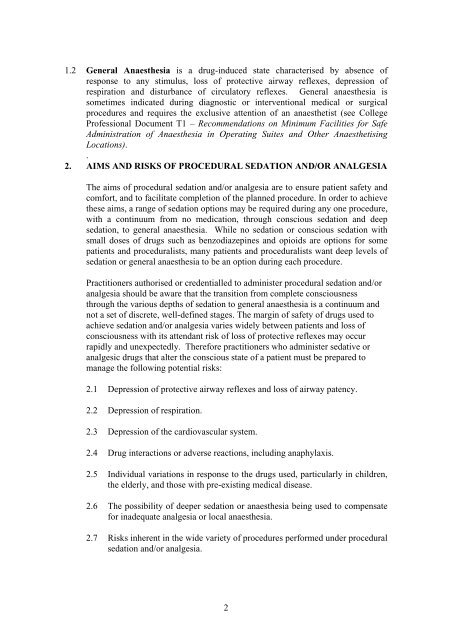clinical indicators - Australian and New Zealand College of ...
clinical indicators - Australian and New Zealand College of ...
clinical indicators - Australian and New Zealand College of ...
Create successful ePaper yourself
Turn your PDF publications into a flip-book with our unique Google optimized e-Paper software.
1.2 General Anaesthesia is a drug-induced state characterised by absence <strong>of</strong>response to any stimulus, loss <strong>of</strong> protective airway reflexes, depression <strong>of</strong>respiration <strong>and</strong> disturbance <strong>of</strong> circulatory reflexes. General anaesthesia issometimes indicated during diagnostic or interventional medical or surgicalprocedures <strong>and</strong> requires the exclusive attention <strong>of</strong> an anaesthetist (see <strong>College</strong>Pr<strong>of</strong>essional Document T1 – Recommendations on Minimum Facilities for SafeAdministration <strong>of</strong> Anaesthesia in Operating Suites <strong>and</strong> Other AnaesthetisingLocations)..2. AIMS AND RISKS OF PROCEDURAL SEDATION AND/OR ANALGESIAThe aims <strong>of</strong> procedural sedation <strong>and</strong>/or analgesia are to ensure patient safety <strong>and</strong>comfort, <strong>and</strong> to facilitate completion <strong>of</strong> the planned procedure. In order to achievethese aims, a range <strong>of</strong> sedation options may be required during any one procedure,with a continuum from no medication, through conscious sedation <strong>and</strong> deepsedation, to general anaesthesia. While no sedation or conscious sedation withsmall doses <strong>of</strong> drugs such as benzodiazepines <strong>and</strong> opioids are options for somepatients <strong>and</strong> proceduralists, many patients <strong>and</strong> proceduralists want deep levels <strong>of</strong>sedation or general anaesthesia to be an option during each procedure.Practitioners authorised or credentialled to administer procedural sedation <strong>and</strong>/oranalgesia should be aware that the transition from complete consciousnessthrough the various depths <strong>of</strong> sedation to general anaesthesia is a continuum <strong>and</strong>not a set <strong>of</strong> discrete, well-defined stages. The margin <strong>of</strong> safety <strong>of</strong> drugs used toachieve sedation <strong>and</strong>/or analgesia varies widely between patients <strong>and</strong> loss <strong>of</strong>consciousness with its attendant risk <strong>of</strong> loss <strong>of</strong> protective reflexes may occurrapidly <strong>and</strong> unexpectedly. Therefore practitioners who administer sedative oranalgesic drugs that alter the conscious state <strong>of</strong> a patient must be prepared tomanage the following potential risks:2.1 Depression <strong>of</strong> protective airway reflexes <strong>and</strong> loss <strong>of</strong> airway patency.2.2 Depression <strong>of</strong> respiration.2.3 Depression <strong>of</strong> the cardiovascular system.2.4 Drug interactions or adverse reactions, including anaphylaxis.2.5 Individual variations in response to the drugs used, particularly in children,the elderly, <strong>and</strong> those with pre-existing medical disease.2.6 The possibility <strong>of</strong> deeper sedation or anaesthesia being used to compensatefor inadequate analgesia or local anaesthesia.2.7 Risks inherent in the wide variety <strong>of</strong> procedures performed under proceduralsedation <strong>and</strong>/or analgesia.2
















